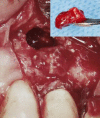Surgical Endodontics vs Regenerative Periodontal Surgery for Management of a Large Periradicular Lesion
- PMID: 29707028
- PMCID: PMC5911307
- DOI: 10.22037/iej.v13i2.20648
Surgical Endodontics vs Regenerative Periodontal Surgery for Management of a Large Periradicular Lesion
Abstract
Treatment success of periodontal-endodontic lesions is dependent on the elimination of both disease causative factors, whether they exist separately or concurrently. This report presents successful endodontic management of a misdiagnosed large periradicular pathology, which had not resolved after a previous periodontal regenerative surgery. A patient complaining of discomfort in the left maxillary region was referred. He had undergone regenerative surgery for treatment of a large periradicular defect; however, there was no further amelioration of the clinical signs/symptoms. Radiographically, a large periradicular lesion filled with bone substitute materials was detected around tooth #25. The endodontic treatment of the tooth was imperfect; therefore, surgical endodontic retreatment was planned. During root-end surgery, the biopsy containing bone substitute materials was obtained. Root-end filling/sealing using calcium-enriched mixture cement was completed. The histopathological examination showed granulation tissues enclosing exogenous materials. In two-year radiographic evaluation, resolving lesion and complete bone healing was observed. The first fundamental step in the management of periradicular lesions is correct diagnosis of the lesion origin and set-by step of the treatment plan according to the main causative factor. Regenerative periodonttal surgery, without considering the defective apical seal, will only cause a painful procedure for the patient without any positive benefit. Following appropriate apical seal, the endodontic lesion healing can be anticipated.
Keywords: Apical Periodontitis; Apical Seal; CEM Cement; Calcium-Enriched Mixture; Diagnostic Errors; Endodontic-Periodontal Lesions; Endodontic Surgery.
Conflict of interest statement
‘None declared’.
Figures





References
-
- Pontes FSC, Fonseca FP, de Jesus AS, Alves ACG, Araújo LM, do Nascimento LS, et al. Nonendodontic lesions misdiagnosed as apical periodontitis lesions: series of case reports and review of literature. J Endod. 2014;40(1):16–27. - PubMed
-
- Rotstein I, Simon JH. Diagnosis, prognosis and decision‐making in the treatment of combined periodontal‐endodontic lesions. Periodontol. 2000;34(1):165–203. - PubMed
-
- Rotstein I, Simon JH. The endo‐perio lesion: a critical appraisal of the disease condition. Endod Topics. 2006;13(1):34–56.
-
- Cohen S, Hargreaves KM, Berman L. Cohen's pathways of the pulp. Mosby Elsivier; 2011. pp. 602–54.
Publication types
LinkOut - more resources
Full Text Sources
